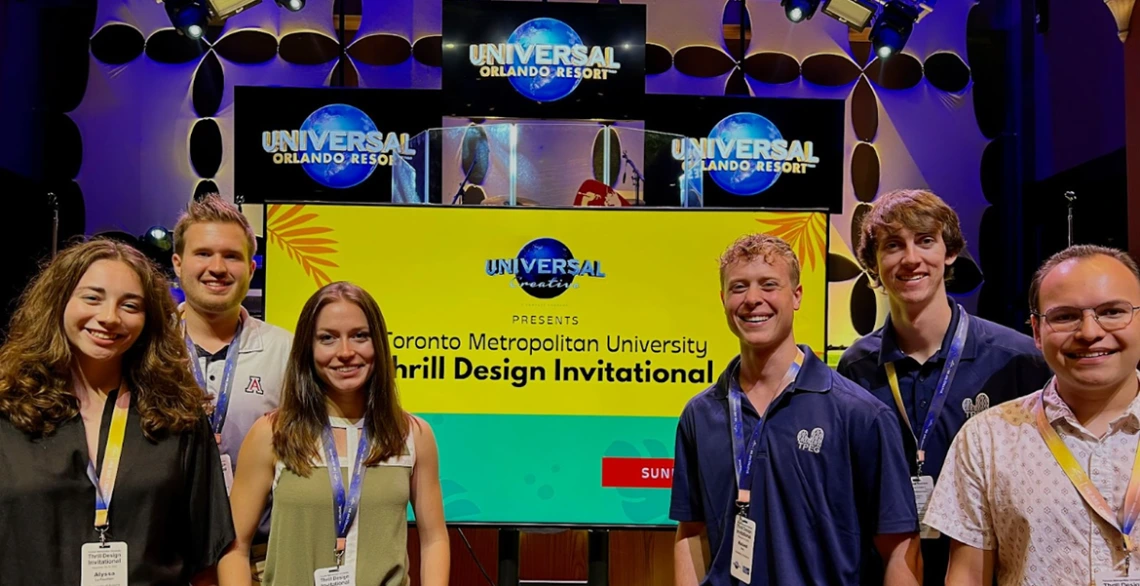Engineering Students Earn Highest Marks at Theme Park Design Competition
Team earns distinctions for technical skill, feasibility, innovation and communication.

Members of Theme Park Entertainment Group at this year's invitational.
Students from the University of Arizona Theme Park Entertainment Group are riding high after success at the Toronto Metropolitan University Thrill Design Invitational in November 2022. The competition in Orlando, Florida invited student groups from 18 universities to present real-world creative, artistic and technical solutions to challenges related to the theme park industry: roller coasters, live shows, mechanical rides and more.
Judges awarded the UA TPEG team the highest marks overall, with distinction for technical skill, feasibility, innovation and communication. The UA engineering students were awarded more commendations per challenge than any other student team.
"Our solutions showed a full consideration of what it takes to entertain: story, emotion, beauty, feasibility and ability to convey our vision into the minds of the judges," said mechanical engineering major Nicholas Sivertson.
The competition was presented by Universal Creative, designers of the Universal Studios parks. Because of the real-world examples, details of the student challenges are bound by a nondisclosure agreement. Students were assigned the challenges and had less than 48 hours to present their solutions to a panel of professionals and industry leaders.
The club formed at the UA in 2017 and has competed at the invitational before. Because the complex theme rides connect mechanics, electronics, architecture and more, TPEG attracts students from many UA engineering majors. The group holds question and answer sessions with industry professionals, designs themed experiences, and occasionally takes trips to local entertainment venues. Michael Marcellin, Regents Professor of Electrical and Computer Engineering, serves as TPEG's faculty advisor.
“There was no better group to represent the University of Arizona at this competition than TPEG’s student competition team – an experienced, interdisciplinary group of graduate and undergraduate students dedicated to pushing the limits of what is possible in safety, creativity, engineering, sustainability and accessibility in the theme park industry,” Marcellin said. “They are decorated veterans of this competition, having brought back several winning trophies in engineering design and accessibility in years prior.”
A Role for Every Engineer
When mechanical engineering major Alex Drey first visited a theme park as a child, many of the rides scared him. However, roller coasters always fascinated him. And the more theme parks he went to, the more he appreciated the themes, environment and systems.
"As a mechanical engineer, I love things that move," Drey said. “When you realize that a roller coaster contains thousands of moving elements that need to function properly in tandem and be reliable for years, accounting for manufacturability, safety, cost, maintenance, and more, you then can understand the amount of time, effort, design, money, trial and error, and engineering that goes into every single aspect of the coaster."
Architectural engineering major Alyssa La Fountain held a unique position on the team, focusing on the challenge of integrating large, complex systems without taking away from the storytelling of the ride.
"In theme parks, you are challenged with making large mechanical and electrical systems look aesthetically pleasing," La Fountain said. "It’s my job as the architectural engineer to come in and make sure I can have these two elements coexist without compromising the work of the architects or engineers on the team."
As an electrical and computer engineering major, Karson Knudson has some words of reassurance for those who enjoy thrill rides.
"Whenever you are planning to go to a permanent theme park, or even a traveling carnival in the United States, you can have some confidence knowing a well-designed computer by a professional electrical engineer has your back," Knudson said.



